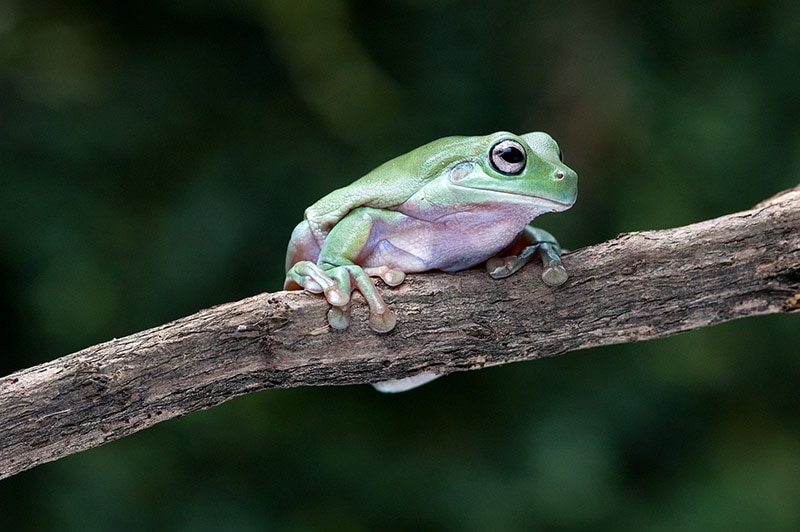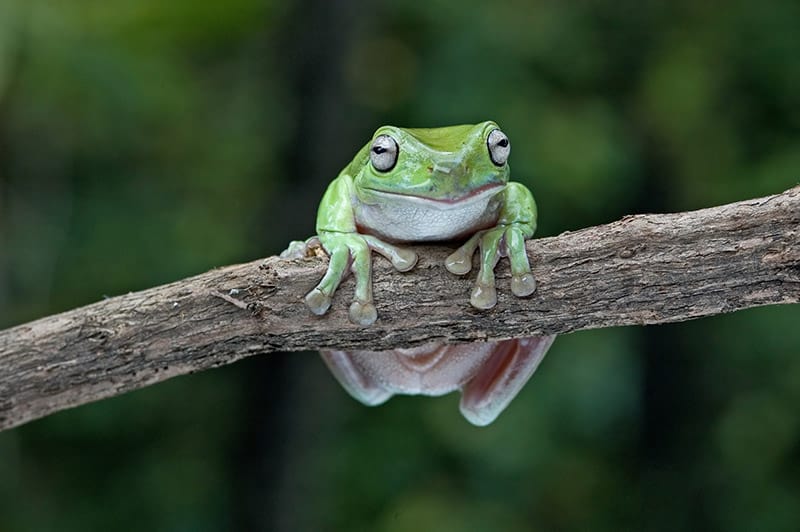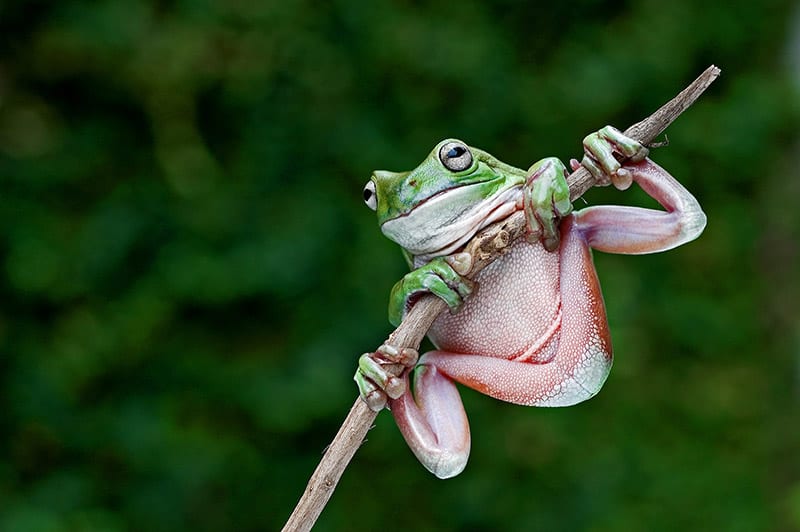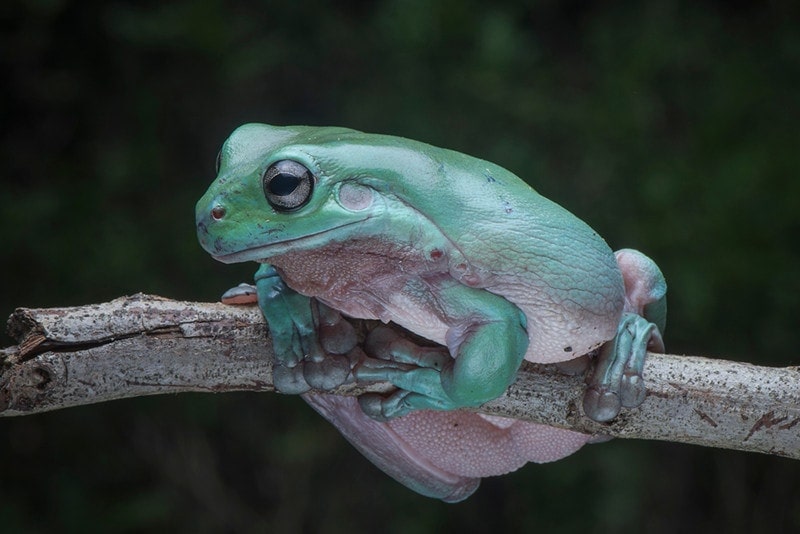The White’s Tree Frog is a cute frog with bulging eyes, and has the most laid back personality!
The White’s Tree Frog Litoria caerulea is one of the most laid back animals there is. It is said that it would take purposeful effort on your part to startle one of these adorably cute frogs. One of the most intriguing acts of the White’s Tree Frog is when are eating. These funny frogs seem to become all legs and elbows as they stuff their food into their mouths with their front feet.
The White’s Tree Frog is a close relative of the White-Lipped Tree Frog. At first glance these two tree frogs seem very much alike appearance but there are a few differences between these “cousins” that are obvious. The White-Lipped Tree Frog is a slightly larger frog and its supratympanal ridges are not as well-developed as they are on the White’s Tree Frog. Also in temperament, the White-Lipped a little moodier than the White’s Tree Frog. It is a little jumpier, more nervous, and just not as laid back.
This frog is very easy to take care of, and it makes it an excellent pet. Unlike many of their relatives, including its close ‘cousin’ the White-Lipped Tree Frog, the White’s Tree Frog is not big on jumping, and will generally only do so when startled. They are an excellent first frog for beginning keepers; even for children, with help from their parents to oversee feeding and occasional misting.
- For more information on keeping frogs see: Guide to a Herptiles: Reptile & Amphibian Care
Scientific Classification
| Kingdom: | Animalia |
| Phylum: | Chordata |
| Class: | Amphibia |
| Order: | Anura |
| Family: | Hylidae |
| Genus: | Litoria |
| Species: | caerulea |
Scientific Name
Litoria caerulea

Habitat: Distribution/Background
White’s Tree frog Litoria caerulea was first described by White in 1790. These frogs are found in Australia. They are arboreal (tree) frogs and are found almost exclusively in the trees except in the breeding season, when they descend to the water sources. They are known by a number of common names including White’s Tree Frog, Dumpy Tree Frog, White’s Dumpy Tree Frog, Blue Dumpy Tree Frog, Smiling Frog, Smiling Tree Frog, Australian Green Tree Frog, Australian White’s Tree Frog, and simply Green Tree Frog (though not to be confused with the American Green Tree Frog Hyla cinerea).
Originally from Australia, some of the first White’s Tree Frogs were exported to the United States in the 1950s. In the early 1970s, these hardy frogs were back in the United States, where herp enthusiasts seized the opportunity to breed them. White’s were commonly bred by a few top herpetoculturists in the late 1980s but seemed to disappear from the hobby until just a few years ago when breeding programs were reestablished with animals raised from the early days and probably from animals arriving from Australia illegally and from breeders in Europe.
True White’s Tree Frogs are still considered to be rare, but now they are appearing more frequently in pet stores.
Status
The Litoria caerulea is on the IUCN Red List for Endangered Species as Least Concern (LC). The White’s Tree Frog has a wide distribution and is adapted to many different habitats.
Description
The normal coloration of a White’s Tree Frog is a jade green. The females are the larger of the species, reaching around 4.5 inches, out-sizing the males by around an inch. They have supratympanal ridges that will form over their eyes, giving them a comical expression. The juvenile frogs’ supratympanal ridges are not as developed as those of the adult.
Although caerulea means dark blue, that is not the true color of the White’s Tree Frog. A blue color can be achieved by keeping frogs in darkened terrariums or feeding them prey insects deficient of beta-carotene (although this diet may encourage anemia). Breeders are breeding for color and there are actual blue specimens and some are beginning to appear that have more white coloration.
White’s Tree Frogs have a long life span of around twenty years, though it is probable that a 25 year old frog could exist. As with almost every frog, these frogs start out as tadpoles.
Food and Feeding
The White’s Tree Frogs are not picky eaters. They will eat many insects as well as crickets, soft (post molt) mealworms, pinky mice (occasionally only), and even other frogs. When feeding crickets it is important to ‘gut load’ them. Many people buying crickets remark that they die shortly upon coming home. This is because the crickets also need food and water to survive.
The best diet for feeder crickets is one rich in variety and calcium. This can include Greenleaf lettuce, redleaf lettuce, romaine lettuce, carrot tops, shredded carrots, squash, apple, and more. Most cricket ‘water bites’ also contain calcium. A commercial gut load is also available. The goal should be to fill the crickets to the brim with vitamins and minerals that your frog will receive upon digestion. This actually makes your frog healthier. “You are what you eat”. If possible, dust the crickets with a mixture containing 1/3 calcium powder containing Vitamin D3 and 2/3 high-quality multi-vitamin powder. (The D3 is the ‘sunshine’ vitamin and is necessary for the ability to use the calcium coming into the body.You could feed all of the calcium in the world but the frog can’t use it without D3.

Housing
For a relatively laid back adult, a 20-gallon ‘high’ tank will suffice, but a single specimen or pair would be better off in a 29 to 30-gallon tank. The species is arboreal (tree-dwelling) and loves to have the height. Any branches (and there should be many) should be about the same width as the frog, as they are not agile and the bigger the branch is, the easier it is to hold on to. A favorite is giant bamboo. The cage needs to be well-ventilated, but escape-proof, so it will require a screen lid. Suitable substrates include cypress mulch, commercial forest bedding, plain potting soil (without perlite or vermiculite), or a peat moss type litter.
They need a SHALLOW water bowl; these frogs have been known to drown in deep water bowls. Keep in mind that they spend time in trees rather than in the water. You can mist the cage three times a week or so as well, as many will lick the water off of the tank walls and it also helps with cleanliness.
White’s do best at a temperature from 76-85{deg} F. You can achieve this with a low wattage day time bulb, no higher than fifty watts (depending on the size of your enclosure), with perches at varying heights so that the frog can move toward the light or away from the light to a place where it is comfortable.
See the terrarium set-ups described under Basic Reptile and Amphibian Care for more information on housing.
Cage Care
Through copious defecation and the habit of smearing their mucous coat, a White’s Tree Frog can dirty up its cage rather quickly. To keep the cage clean, misting daily can help, but once every week or two, mist the cage with purified or distilled water and wipe it down with a clean rag to get the mucous coat off of the side of the aquarium.
Behavior
White’s Tree Frogs do well alone, in pairs, or even in large groups, provided that there is enough space for them all. They are easily handled and do not jump unless startled, which is pretty hard to do. They do well with children and adults alike and can be handled with ease. Because of the secretion of mucous, it is recommended that you wash your hands before and after handling.
Handling
They are easily handled and do not jump unless startled, which is pretty hard to do. The White’s Tree Frog will do well with children and adults alike and can be handled with ease. Because of the secretion of mucous, it is recommended that you wash your hands before and after handling.

Reproduction
Breeding White’s Tree Frogs involves hibernating them for about 6 weeks followed by a 2 – 4 week period of feeding them and maintaining them at their optimal temperature just prior to breeding. You must also prepare a large aquarium for the breeding and tadpole raising to take place. While the aquarium is cycling you can prepare your frogs for breeding.
- Preparing the Aquarium:
You need to have a well-cycled aquarium of at least 100 gallons. Preparing the aquarium is relatively easy to do. Be sure to use dechlorinated water. It is easy to do this by setting up a large tank, maybe three quarters of the way full, and putting in feeder goldfish. The aquarium will be ‘cycled’ and ready for the frogs when there are no longer any harmful substances, such as ammonia and nitrites in the water. This usually takes about six weeks. There are test kits that you can purchase to test your pH, ammonia, and nitrite. As far as the range goes, pH should be from 6.8 to 7.2, while ammonia and nitrite should be at zero. For information on cycling the aquarium see: Cycling Your Aquarium.
Once the water is established, add a submersible heater to keep the water in the 80{deg} to 85{deg} F. This will be ideal for the tadpoles as they grow.
Provide plenty of aquatic plants, such as anacharis, Amazon swords, micro swords, crypts, wisteria, or others, as well as a floating dock of sorts for the frogs.
You also need to set up a rain chamber. This can be as simple as a large plastic box with many holes poked in the bottom, connected to PVC pipe with water running through.
- Preparing the frogs:
While you are preparing your tank, you can cool the adult frogs for a few weeks to prepare them for breeding. To hibernate your frogs, take two specimens of different genders that are healthy, at a good weight, and are in their second year or older (which is when they reach sexual maturity). Make sure that they have defecated from their last meal before you begin the cooling process. Cooling with feces in their digestive system can prove fatal.
You will want to keep them at temperatures of around 65{deg} F with half of their screen top covered. You can keep them at these temperatures for as many as 16 hours a day. Keep the aquarium dark and offer no food at this time. You need to keep your frogs on this schedule for six weeks prior to breeding them. If at any time you see any signs of illness (eyes are not clear and bright, drastic weight loss, etc.), remove the frogs from artificial hibernation and slowly warm them up to room temperature.
- Breeding and the tadpoles:
To induce breeding, place the prepared frogs into the aquarium. You will want to keep the rain chamber running six to ten hours at night once the frogs are introduced. Breeding will occur in the ‘dry’ periods when the rain chamber is not running.
It may take two to five days for breeding. Once breeding has occurred, remove the parents.There could be one thousand or more eggs that will hatch into tadpoles in 24 to 36 hours. The tadpoles will hover at the bottom of the tank but will become active within another 24 to 36 hours. Provide natural light if possible. If natural light is not a possibility, provide full-spectrum fluorescent lighting in a shoplight mounted 12-18″ overhead.
After the third or fourth day, you can start feeding a high quality fish food. You want there to be no more than 15 tadpoles to one gallon of water. Keep a very close eye on your water quality, preferably checking it at least once a day. The first metamorphed frogs will appear at around four weeks but some will morph much later.
The biggest challenge in breeding White’s Tree Frogs is the maintenance for hundreds or thousands of frogs, their food and caging requirements, and keeping crowding under control.
Diseases: Ailments/Treatments
The White’s Tree Frog is very hardy, but as with all frog species health and hygiene go hand in hand. Frogs absorb most of their moisture through their skin. Pathogens from contaminated water or feces will also readily be absorbed. Providing a proper environment and keeping it clean is the best way to keep a happy healthy frog.
Some of most common problems encountered by frogs include a bacterial disease called ‘Redleg’, intestinal impaction from ingesting sand or gravel when eating, blindness, fungal infections, Metalic Bone Disease (MBD) from insufficient calcium and vitamin D3, endoparacites, and stress. These can be avoided with proper care and nutrition, and a good clean environment.
Availability
White’s Tree Frogs are becoming more readily available and can be purchased for anywhere between $20 and $50, depending on size.
Featured Image Credit: Hwe Ie, Shutterstock
